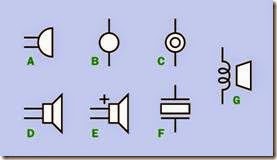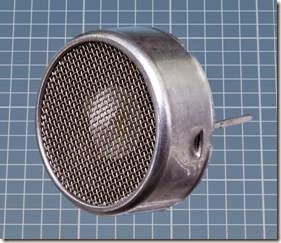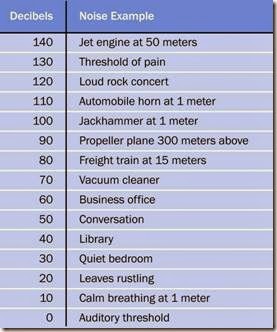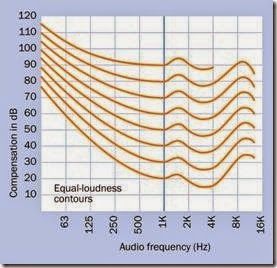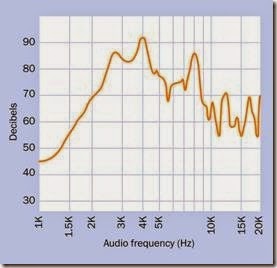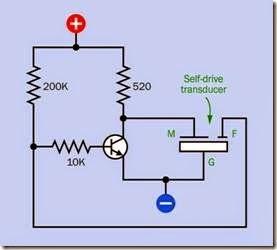transducer
The term transducer is used here to describe a noise-creating device that is driven by external electronics. By comparison, an audio indicator (discussed in the next entry) contains its own internal electronics and only requires a DC power supply. Either of these components is often described as a beeper or buzzer.
A speaker, more properly termed a loudspeaker, is an electromagnetic transducer but is seldom described in those terms. It has a separate entry in this encyclopedia and is defined here as a sound reproduction device that is larger and more powerful than a typical transducer and has a more linear frequency response.
While piezoelectric transducers formerly used crystals, only the more modern piezo- electric type that uses a ceramic wafer will be considered here.
Some transducers convert sound into electricity, but these are categorized as sensors, and will be discussed in Volume 3. The only transducers discussed in this entry are those that convert electricity into sound.
An audio transducer is a device that can create an alert. It requires an AC signal that is supplied by external electronics, and in its simplest form may be referred to as a buzzer or a beeper.
Audio alerts are used in microwave ovens, washer/dryers, automobiles, gasoline pumps, security devices, toys, phones, and many other consumer
tones. Type A is probably the most popular symbol. Types B and C often appear with the word “buzzer” printed beside them for clarification. D and E are really symbols for a speaker, but are often used for an alert. F is the symbol for a crystal, now sometimes used to indicate a piezoelectric noise maker. G specifically represents an electromagnetic transducer, but is seldom used.
How It Works
products. They are often used in conjunction with touch pads, to provide audio confirmation that a tactile switch has been pressed.
The schematic symbols in Figure 27-1 can be used to represent any kind of audio alert, includ- ing indicators, which contain their own electronics to generate a simple tone or series of A circular diaphragm is glued at its edges inside a cylindrical plastic enclosure, usually measuring from around 0.5” to 1.5” in diameter. The enclosure is sealed at the bottom but has an opening at the top, so that sound can emerge from the upper side of the diaphragm without being partially cancelled by sound of opposite phase that is emitted from the underside of the diaphragm. The enclosure also amplifies the sound by resonating with it, in the same way that the body of a guitar or violin amplifies a note being played on the strings.
Figure 27-1. An assortment of symbols which can repre- sent a transducer or an indicator. See text for details.
The diaphragm is activated either electromagnetically or piezoelectrically, as described next.
Externally, a transducer may be indistinguishable from an audio indicator such as the one pic- tured at Figure 28-1.
Variants
Electromagnetic
An electromagnetic transducer contains a diaphragm that is usually made of plastic. Mounted on it is a smaller ferromagnetic disc that responds to the fluctuating field from AC passing through a coil. When the diaphragm vibrates, it creates pressure waves that are perceived by the human ear as sound.
A car horn is a particularly loud form of electro- magnetic transducer.
Piezoelectric
A piezoelectric transducer contains a diaphragm consisting of a thin brass disc on which is moun- ted a ceramic wafer. When an AC signal is applied between the piezoelectric wafer and the disc, the disc flexes at that frequency.
The term piezo is derived from the Greek piezein, which means “to squeeze or press.”
Ultrasonic Transducer
The diaphragm in an ultrasonic transducer vibrates at a frequency above the range of human hearing. This component may be electromagnetic, piezoelectric, or crystal-based. Often it is used in conjunction with an ultrasonic receiver as a distance measuring device. The two components can be sold pre-mounted on a breakout board. An output from the board can consist of a pulse train where the pulse duration is proportional to the distance between the transducer and the nearest sound-reflecting object.
An ultrasonic transducer is pictured in Figure 27-2. Its internal components are shown in Figure 27-3.
Figure 27-2. The exterior of an ultrasonic transducer.
Submersible ultrasonic transducers may be used in cleaning systems, where they agitate a liquid that dislodges dirt or debris. Ultrasonic transducers are also used in echo-sounding and sonar equipment with marine applications.
Figure 27-3. Inside an ultrasonic transducer, a small aluminum cone is the sound radiating element. The white blobs are adhesive to secure the thin wires.
Formats
Some transducers are available in surface-mount format, measuring about 0.5” square or less. Be- cause the resonant frequency is related to the size of the component, surface-mount transducers usually generate a high-pitched beep.
Values
Frequency Range
Audio frequency is measured in Hertz, abbreviated Hz, named after Heinrich Rudolf Hertz, the first scientist to prove the existence of electro- magnetic waves. The H in Hz is capitalized be- cause it refers to a real name. One thousand Hertz can be written as 1 kiloHertz, almost always abbreviated as 1kHz (note that the k is lowercase).
The human ear is often described as being able to detect sounds between 20Hz and 20kHz, al- though the ability to hear sounds above 15kHz is relatively unusual and diminishes naturally with age. Sensitivity to all frequencies can be impaired by long-term exposure to loud noise.
The most common frequencies applied to audio transducers range between 3kHz and 3.5kHz.
Piezoelectric elements are inefficient for generating sounds below 1kHz, but electromagnetic transducers are better able to generate lower frequencies. Their response curve can be approximately flat to frequencies as low as 100Hz.
Sound Pressure
Sound pressure can be measured in Newtons per square meter, often abbreviated as Pa. Newtons are units of force, while Pa is an abbreviation of Pascals.
The sound pressure level (SPL) of a sound is not the same as its sound pressure. SPL is a logarithmic value, to base 10, in units of decibels (dB), derived from the pressure of a sound wave relative to an arbitrary reference value, which is 20 micro-Pascals (20µPa). This is the agreed minimum threshold of human hearing, comparable to a mosquito at a distance of three meters. It is assigned the level of 0dB.
Because the decibel scale is logarithmic, a linear increase in the decibel level of a sound does not correspond with a linear increase in actual sound pressure:
• For each additional 6dB in the SPL, the actual sound pressure approximately doubles.
• For each additional 20dB in the SPL, the actual sound pressure is multipled by 10.
Bearing in mind that 0dB corresponds with the reference sound pressure of 20µPa, an SPL of 20dB represents a sound pressure of 200µPa (that is 0.0002Pa), and so on.
Many tables show an estimated decibel level for various noise sources. Unfortunately, these tables may contradict each other, or may fail to mention the distance at which a sound is measured. Figure 27-4 shows estimates derived by averaging eight similar tables. It should be viewed as an approximate guide.
Figure 27-4. Approximate decibel values for some sound sources (averaged from a selection of eight similar charts).
Sometimes the claim is made that an increase of +10 on the decibel scale will correspond with a subjective experience that the noise is “twice as loud.” Unfortunately, this statement cannot be quantified.
Weighted Sound Values
Subjective assessment of sound is complicated by the nonlinear frequency response of the hu- man ear, which causes some frequencies to seem “louder” than others, even though their sound pressure is the same. The frequency weighting of the ear can be determined by playing a reference tone of 1kHz at 20dB and then doing an A-B comparison with a secondary tone at another frequency, asking the subject to adjust the gain of the secondary tone up or down until the two tones seem equally loud.
This procedure is performed for a range of frequencies. The test is then repeated with a louder 1kHz reference tone, at 30dB. Repetitions continue to a final reference tone of 90dB.
The resulting curves are known as equal-loudness contours. An averaged set, from multiple sources, has become an international standard with ISO number 226:2003. The curves shown in Figure 27-5 are derived from that standard. The curves show that the sound pressure of lower frequencies must be boosted by a significant amount to sound as loud as a 1kHz frequency, while a frequency around 3kHz must be reduced slightly, because it tends to sound louder than all others.
Figure 27-5. Equal loudness contours derived from ISO 226:2003. See text for details.
Although the accuracy of equal-loudness con- tours is controversial, they have been the basis of a widely used weighting system to adjust dB values to represent subjective perceptions of loudness. This A-weighting system remains the best-known and most widely applied audio standard in the United States, even though it has been criticized for assigning too little value to sounds that are brief in duration. If a sound level is expressed in dBA, it is A-weighted, meaning that the sounds to which the ear is least sensitive are assigned a value that is lower than their measured value. Thus, a tone of 100Hz has a dBA value about 20dB lower than its dB value, be- cause the human ear is relatively insensitive to low-pitched sounds. dBA values are used in reg- ulations that limit noise in the work place and other environments.
Unweighted Values
If sound intensity is expressed in dBSPL, it is a measurement of the actual Sound Pressure Level and has not been adjusted with the A-weighting system. A graph of unadjusted dbSPL values will display low frequencies as if they are more in- tense than the ear will perceive. In practical terms, subjective perception of low-end rolloff will be even more severe than the graph makes it appear.
If sound intensity is expressed merely in dB, probably it is unweighted and should be considered as dBSPL.
From a practical point of view, when choosing a tone for a transducer, a 500Hz tone may sound relatively mellow and not subjectively loud. A 3.5kHz tone can be a good attention-getting sig- nal, as the ear is most sensitive in that range.
Transducers generally have a sound pressure rat- ing in dBSPL ranging between 65dBSPL to 95dBSPL, with just a few products that can make more or less noise.
Measurement Location
The sound pressure from an audio alert will naturally diminish if the measurement point moves farther away. Therefore, any rating in decibels should be expressed with reference to the distance at which the measurement is made.
Measurement locations may be expressed in centimeters or inches, and may vary from 10cm to 1 meter, even in datasheets for different devi- ces from the same manufacturer. If the measurement distance doubles, the SPL diminishes by approximately 6dB.
Limitations
A piezoelectric transducer is not intended as a sound reproducer, and does not have a smooth or flat frequency response. The curve for the Mallory PT-2040PQ is not unusual, reproduced in Figure 27-6. This component measures about 3/4” in diameter, is rated for 5VDC, and uses only 1.5mA to generate 90dB (measured at a distance of 10cm). Like many piezoelectric audio devices, its response peaks around 3500kHz and diminishes above and below that value, especially to- ward the low end. While it is perfectly adequate as a “beeper,” it will not reproduce music successfully.
Figure 27-6. The frequency response from a typical small piezoelectric transducer.
An electromagnetic transducer is better able to generate low frequencies than a piezoelectric transducer. It has a low impedance that may be suitable in some circuits. However, it is slightly heavier than a comparable piezoelectric transducer, uses much more power, and as an AC de- vice containing a coil, it can create electromagetic interference or may cause fluctuations in the circuit as an inductive load. It is also vulnerable to magnetic interference from elsewhere, while a piezoelectric transducer is not.
While an electromagnetic transducer can be used to reproduce speech or music, and will do a better job than a piezoelectric transducer, its performance will still be dissatisfying. A miniature speaker is more appropriate for the task.
Voltage
Transducers are typically designed to work with voltages ranging from 5VAC to 24VAC. The ceramic wafer in a piezoelectric transducer usually cannot withstand voltages much above 40VAC, and its sound output will not increase significantly above 30VAC.
Current
Typical piezoelectric transducers use less than 10mA and generate negligible heat. An electro- magnetic transducer may draw as much as 60mA.
How to Use It
Appropriate Sound Intensity
An alert should be chosen with reference to the environment in which it will be used. To be easily heard, it should be at least 10 dB louder than ambient background noise.
Volume Control
Sound pressure can be lowered by reducing the voltage. Because a transducer does not consume much current, a trimmer can serve as a volume control. Alternatively, a rotary switch with a set of fixed-value resistors can select preset sound values.
AC Supply
Although a transducer is an AC device, it is un- likely to be designed for voltage that fluctuates positively and negatively either side of a neutral value. Typically it is intended for voltage that fluctuates between 0V (ground) and the rated positive value of the power supply, and its pins, wires, or terminals are usually marked accordingly. If it has wire leads, the red lead should be connected to the more-positive side of the sup- ply. If it has pins, the longer pin should be more positive.
The alternating signal for a transducer can be supplied by any simple oscillator or astable multivibrator circuit. For a given peak voltage, a square wave will generate a louder signal than a sinusoidal wave. A simple 555 timer circuit can be used, with a second monostable timer to limit the duration of the beep if necessary. An astable 555 can be used to test the transducer and select the audio frequency that sounds best.
Self-Drive Transducer Circuit
If a transducer has three wires or pins, it is prob- ably a self-drive type. The datasheet may identify its inputs as M, G, and F, meaning Main, Ground, and Feedback. The Feedback terminal is connected with a section of the diaphragm which vi- brates 180 degrees out of phase with the Main terminal. This facilitates a very simple external drive circuit, such as that in Figure 27-7, where the frequency is determined by the transducer’s resonant frequency.
Figure 27-7. A circuit to control a self-drive type of piezo- electric transducer.
What Can Go Wrong
Overvoltage
Mallory Sonalerts, one of the largest producer of piezoelectric alerts, states that in the “vast majority” of returned products, the failure was caused by excessive voltage, often in the form of a transient voltage spike.
Leakage
If an alert makes a small, low-volume sound when it is supposed to be off, some current is leaking through it. Less than 1mA may be enough to cause this problem. According to one manufacturer, it can be fixed by placing a 30V Zener transient voltage suppressor diode in ser- ies with the alert, or by wiring a small incandescent lamp in parallel with the alert.
Note that when the alert is activated, the full supply voltage will be seen at the lamp.
Component Mounting Problems Some alerts are packaged with mounting holes, but many are not. Those with pins can be soldered into a board, but those without must be
glued in place or inserted into a cavity from which they cannot shake loose. Silicone adhesive is recommended, but care must be taken to avoid any of it dripping into the alert before it sets.
Moisture
If an alert will be used in a location where it is vulnerable to moisture, it should be of a type that is sealed against the environment. Even a sealed unit should ideally be oriented so that it faces slightly downward.
Transducer-Indicator Confusion Externally, a transducer and an indicator often look identical, and some of them are not marked with a manufacturer’s part number. Damage can be caused by applying DC to a transducer or AC to an indicator. If both types of parts are kept in inventory, they should be carefully labeled.
Connection with a Microcontroller A piezoelectric transducer can be driven by a mi- crocontroller, but an electromagnetic transducer is not appropriate in that role, because of its relatively higher current consumption and its behavior as an inductive load.

